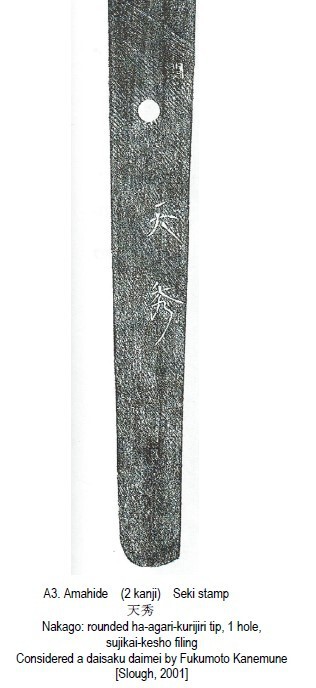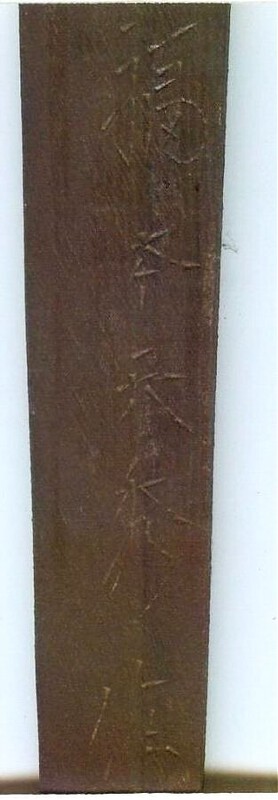-
Posts
10,909 -
Joined
-
Last visited
-
Days Won
128
Content Type
Profiles
Forums
Events
Store
Downloads
Gallery
Everything posted by Bruce Pennington
-
This is the closest Masahiro on JSI I could find. I have tons of Masahiro on file, but none with this script-style writing.
-

Help with a bit of information on this type 95
Bruce Pennington replied to JohnWB's topic in Military Swords of Japan
Now you need a Nagoya side-latch, and a copper! Ok, maybe a late-war wooden handle too! Then there's the .......... -

Help with a bit of information on this type 95
Bruce Pennington replied to JohnWB's topic in Military Swords of Japan
Pg 16 of the Stamps Doc: "Sha" - private contractor/factory The fuchi stamps on the left show the contractor company that made the gunto. As I understand it, each one of them fully made the sword, blade, and fittings. For Type 95s, they did this work under contract for an arsenal, either Tokyo 1st or Nagoya. Prior to 1942, they were still making them for these 2 arsenals, but we see the stacked cannonball stamp of the supervising Kokura Army Arsenal, with the small inspector stamp in the middle showing us whether it was Tokyo or Nagoya receiving the gunto. Yours has the Tokyo 1st star, so the gunto was made 1942 or later. @Shamsy or @Stegel could tell you a year, but neither of them are on the forum much lately. Maybe @Kiipu or @BANGBANGSAN can give you an idea. -
-
I haven't followed the issue of fake mon, but the swords brought to this forum have always seemed legit. There may be previous discussions of mon use out there that I am not aware of, but I've always found it interesting that in the early years of Westernization, kyu gunto quite often had mon. I'd bet a slight majority of them did. But it is less common on shingunto. Just brainstorming, but maybe there were a higher percentage of officers in the pre-WWI days that had samurai lineage? Then in WWI & WWII, a great number of "common" people entered the ranks without family mon?
-

Attention Mantetsu Owners: A Survey
Bruce Pennington replied to Bruce Pennington's topic in Military Swords of Japan
Ok, great, Ray! I posted some photos from the auction here: Kyu Corner. They only posted a rubbing of the nakago, so real photos would be great when able. Some of us were following that auction, hoping the winner would bring it to the forum. Really appreciate you bringing it in! -

Attention Mantetsu Owners: A Survey
Bruce Pennington replied to Bruce Pennington's topic in Military Swords of Japan
Ray, That's not just an early B - it's the first B we have ever seen/recorded!!! Please post full nakago shots of both sides, I need the date. Oh, and a photo of the overall fittings, too, please! Is it per chance a Navy kyu? -
You can read all about these stamps on the Stamps of the Japanese Sword article.
-

Any Shin Gunto With "battle Scars"?
Bruce Pennington replied to PNSSHOGUN's topic in Military Swords of Japan
I know almost nothing about bending, but I have read a couple times where blades bent when cutting, like beheading. There is a famous confession of a WWII officer who stated that he preferred one sword over another (he said the smith names, but I don't remember them) because one bends when he cuts heads off. -
There isn't a "should" or "shouldn't". The Seki Cutlery Manufacturers Assoc. stamped blades as they inspected them. It is claimed they only inspected showato. Arsenals also stamped blades they inspected and accepted. We believe those stamps are only on showato. The only gendaito blades we know of with stamps are the blades made under the RJT program, and they have a star, and sometimes small seki, "na", and other stampings. Having said that, there are many, and I mean many, blades that went to market that were never inspected by either the Assoc. nor the arsenals, and a good percentage of them were showato. So, an unstamped blade could be either showato or gendaito. Only an informed inspection can help determine which one a blade falls into.
-
Slight correction - the stamp on the mei side is the Gifu stamp No one knows exactly who was using the stamp. It was either the Seki Cutlery Manufacturers Association or the Nagoya Army Arsenal. The small stamp at top on the date side is the small Seki stamp of the Seki area inspector from the Nagoya Army Arsenal. The presence of either would tell us the blade wasn't made in the traditional manner. Sesko lists 2 Kanemune smiths in WWII. Don't know which one this would be: KANEMUNE (兼宗), Shōwa (昭和, 1926-1989), Gifu – “Kanemune” (兼宗), real name Fukumoto Koichi (福本小市), born October 14th 1902, adopted son-in-law of Fukumoto Amahide (天秀), he died on March 8th 1977, ryōkō no jōi (Akihide) KANEMUNE (兼宗), Shōwa (昭和, 1926-1989), Gunma – “Kanemune” (兼宗), family name Kiribuchi (桐淵), he worked as a rikugun-jumei-tōshō, ryōkō no jōi (Akihide), Fifth Seat at the 6th Shinsaku Nihontō Denrankai (新作日本刀 展覧会, 1941)
-
Hmmm. Two paragraphs down, he said: "The program only required the blades, but owners who wished to sell the swords complete with Koshirae was paid for the Koshirae as well." So, maybe swords that came with koshirae got the leather cover treatment rather than a Type 98 refit. Still doesn't explain why so many tsuka are partially refitted or not refitted at all, and what's the difference? And we still have the private shops, and businesses, that were selling old blades fitted out (in what fashion?) to new officers.
-
This might be a good location for this discussion: Alex, @aabderson, and I were chatting about the program for converting civil/private swords for the military, and why does there seem to be no standardization. My response: Nick Komiya's article on the effort to get people to donate or sell their family swords to the military? Program for converting family blades and short blades into Gunto and Swords out of stock Alert They had a desired length of blade, but unless I missed something, there was no specified way to re-fit them. I think the old blades we see fully decked out in Type 94/98 fittings were likely brought to a shop, personally, for military koshirae, or, they were bought by private shops and refitted for sale. There were over 1,200 active sword shops in Japan during the war, selling swords. I believe the ones with little or no military hardware and just a leather cover were possibly the swords donated and/or bought up by the military in mass quantities, and the minimum done to prep them for miilitary use. I could have that backwards, but we are just speculating. Edit: after re-reading Nick's article, I may have that backwards: "It was a program supported by the local Veterans Association as well as the Taiseiyokusankai Political Party. Municipalities would announce the dates and venues of the appraisal sessions and the army sent its appraisers to do preliminary screening. Only the swords that passed this screening were sent further to the HQ of the Officer Gunto Appraisal Committee 将校軍刀監査委員会 for a full screening to determine a fair price. Owners of swords that passed got a notice of appraised value through their local municipal office and the money was remitted by the Gunjinkaikan. Those swords were polished and set into proper new Koshirae and sold to Army officers." So, what I'm wondering, is if anyone has any knowledge on the question of why we see so many private swords with a wide variety of military hardware, sometimes none, and then a leather covered saya? Were the private sword shops doing this? Were the arsenals doing it to save time and resources? Ideas and/or documentation welcome!
-
Does the screw not turn at all, or does it spin without coming out?
-
Thanks Piers! Thomas, over on a Warrelics thread, confirmed the same thing. No, this is the only writing observable.
-
-

Showa-to from Amahide's workshop
Bruce Pennington replied to Yukihiro's topic in Military Swords of Japan
Hi Didier, The date is 1941, and the mei is a good match for the one in Slough where he contends it is daimei for Kanemune. I have another Amahide with a 4 character mei, so Slough may be right. Slough's example An actual I see nothing to indicate the ito isn't original, in fact, it shows wear and tear I would consider WWII legit. While the painted number is pretty rough, it very well could be a sloppy "10". I thought at first it was a "14", but it could be a 10. I differ with Francois, in that original fittings quite often have matching numbers. Now, there are plenty, and I mean plenty, of gunto with non-matching numbers. Even gunto with 2 different painted numbers. So, those could have been wartime re-fits, or post-war piece-togethers, but the fully complete, original gunto, when found in pristine condition (just see some of IJASWORDS examples) all have matching numbers. The hamon does seem to have the telltale dark peaks that would indicate an oil quench. But, typical of large seki stamped blades, it is a good looking blade and a good looking gunto. -
Wow, good one, John!
-
Matt beat me to it. Lousy condition, but you can see hints of interesting hamon when you zoom in. Here's the link to the sale: Fare sales on ebay




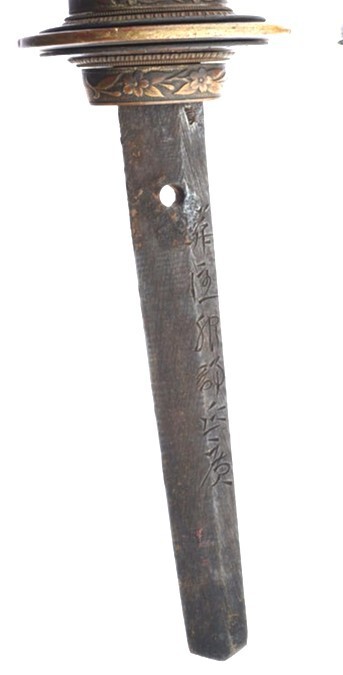








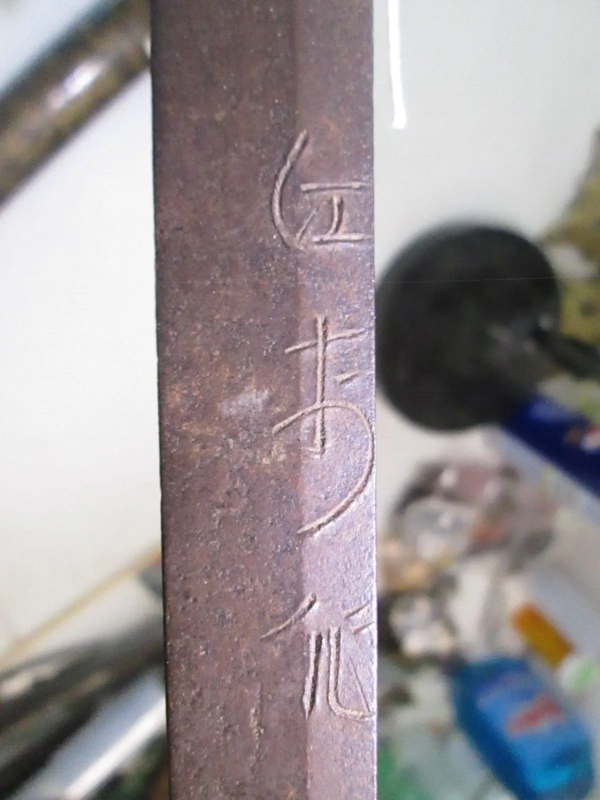
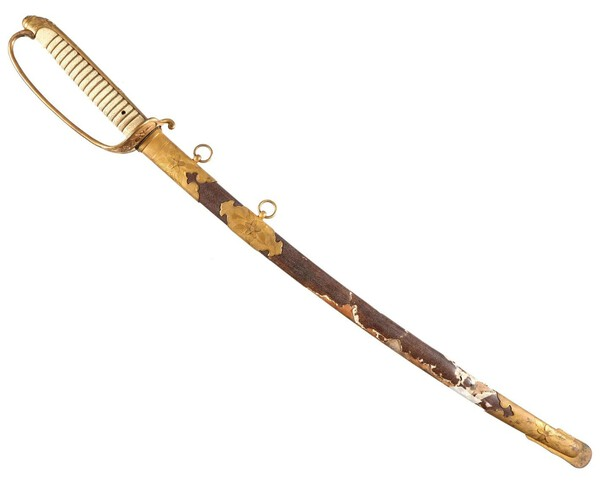
.jpg.d234e0a30a7aa4a2c8fe60c3971012fe.jpg)



